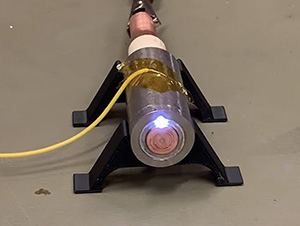How to bootstrap from idea to orbit

In this guest post, Matija Milenovic, KTH alum and co-founder of spacetech startup porkchop, shares their journey from idea to orbit.
Something not many people know about porkchop is that our journey from idea to orbit was done at an incredibly low cost, and in a quick time-frame despite the pandemic and us being students. In this post, I want to shed some light on how we did that, and it has shaped porkchop’s culture moving forward.
The beginnings of porkchop are really similar to the premise of Phineas and Ferb. Myself and my co-founder, Victor, tried finding summer jobs or internships in Stockholm during our first summer here. After several months of sending out CVs and filling out forms, we got a grand total of zero acceptances.
The early days of porkchop.
Around the same time, I had begun developing a knack to start a business, and it was something I talked a lot about with those around me. Victor happened to hear me, and a few weeks later came up to me with a brochure for ESA BIC Sweden. We decided to focus on propulsion, as we saw a gap to be filled and felt that that’s where we had the best possibility to make an impact on the space industry, and we had some basic electronics and mechanical engineering knowledge.
The first place we went to for support was KTH Innovation. KTH Innovation provides early-stage ideas with access to various public Swedish grants such as Vinnova, Almi and Tillväxtverket. They also taught us the basics of how to run a business, how to speak with investors, and how to get your first traction and customers.
The total funding we received by late 2019 was around 25,000 SEK (~$2,500), with the goal of building a “minimum viable thruster” and getting it to fire. We used a lot of that budget to buy raw material (titanium, alumina ceramic, and copper) tubes, and manually lathed them ourselves. It’s a really imprecise way of doing it, and neither me nor Victor have a steady hand, but it was the only way we could afford to do it. The next major hurdle was getting access to a vacuum chamber.
We thought that it would be a matter of just asking, but when we inquired, we realised getting access to a multi-million-kronor vacuum system won’t be possible in the near-term. This pushed us to buy one from Amazon for about $150. Its performance was really bad as the lowest pressure achievable isn’t close to what satellites experience, but it was enough to perform initial tests. I think they’re mainly designed for drying foods.

The result of our first grant: our first thruster firing in Autumn 2019. Some firings (like the one above) were done in air since we were too impatient to set up the vacuum chamber.
Getting that thruster to fire was a challenge (looking back, there were so many things we overlooked), but after we finally got it to work, we could come back to KTH Innovation and request more funding following our demonstration of the thruster firing. To compliment the grant funding, we were also using our own money for various materials, web domain and hosting, electronics, and so on. I estimate I personally spent close to $7,000 just on these “micro-transactions” in the first two years (still on a student budget), leading me to the conclusion that it probably would’ve been cheaper to pick up a smoking addiction instead.
Following that first grant from KTHI, we received other ones, for larger amounts, to not just develop technology but also validate the market need. We rode this wave of write grant -> get money -> prove concept -> repeat from then until we got a launch slot, built many test units, and finally a flight unit. Over the course of our first year, we managed to receive around 100,000 SEK ($10,000) over the course of several installations.
A funny thing to look back on is that we didn’t actually receive any of this money, but rather it was reimbursed back to us, since porkchop wasn’t incorporated yet and we were doing all this as private individuals. That meant that we would request reimbursements when my card would decline. It was great!
This is somewhere where I must really commend Sweden’s ability to support at the idea stage — some bureaucratic paper-pusher could have seen me and Victor as two novices with no idea of what we were doing (and they’d be right), before simply dismissing us. By giving us only that initial grant, they allowed us to prove our concept, which we otherwise wouldn’t have the cash to do ourselves. I really think that this is a safe bet for any organisation (including porkchop today) to make: always give people a chance to prove themselves.
The second-order effect of these grants was that they allowed us to develop porkchop as a company, and pushed us to reach milestones to keep the cash coming in. As the saying goes, “money attracts money”, and those grants further helped us getting other funding such as that from ESA BIC and from KTH Holding as a micro-investment.
We ultimately officially stopped being a bootstrapped startup in December 2021, when we closed our pre-seed round. Weeks afterwards, porkchop gained space heritage as a company. We learned many things in our 2.5 years of bootstrapping:
- The small size of the grants we were receiving made us become an extremely capital efficient organisation — the memories of tracking, justifying and reporting the spending of every single kronor are still raw in both mine and Victor’s heads.
- With the above in mind, it is important to learn when to penny-pinch and when not to. Cheaping out for the wrong things can ultimately be more expensive, give you severe buyers’ remorse, or both. We’ve made our fair share of mistakes here.
- Not having a lot of money hardens you as founders, but it does also force you to make some extremely difficult decisions. Grant funding (at least that which we’ve received) is generally not usable to pay wages/salaries. This means you have to figure out visas/rent/groceries/etc for yourselves. It also means you can’t hire people who could help accelerate the company. Don’t expect a walk in the park.
- Not having credibility in the beginning makes things 100x harder, but not impossible. Look for opportunities to get some small amount of cash to prove a concept, build a prototype or validate a hypothesis. Grant funding is one of many options, including: part-time jobs, gig work, micro-investment, etc.
- Finally, there’s no shame in using non-space equipment for developing space technologies! We used an electric pizza oven for drying epoxy when assembling flight hardware. Another great example is using tape measures as antennas in CubeSats. You have to start somewhere.
Originally posted on Medium by Matija Milenovic. Adapted by Lisa Bäckman.
